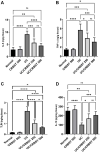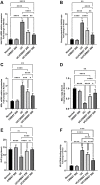Carbocisteine as a Modulator of Nrf2/HO-1 and NFκB Interplay in Rats: New Inspiration for the Revival of an Old Drug for Treating Ulcerative Colitis
- PMID: 35754464
- PMCID: PMC9214041
- DOI: 10.3389/fphar.2022.887233
Carbocisteine as a Modulator of Nrf2/HO-1 and NFκB Interplay in Rats: New Inspiration for the Revival of an Old Drug for Treating Ulcerative Colitis
Abstract
Ulcerative colitis (UC), an inflammatory bowel disease, is a chronic condition of a multifaceted pathophysiology. The incidence of UC is increasing internationally. The current therapies for UC lack relative effectiveness and are associated with adverse effects. Therefore, novel therapeutic options should be developed. It has been well documented that modulating the Nrf2/NFκB is a promising therapeutic target in inflammation. Carbocisteine is a mucoregulatory medication and its efficacy in COPD was found to be more closely related to its antioxidant and anti-inflammatory properties. Carbocisteine has not yet been examined for the management of UC. Hence, our approach was to investigate the potential coloprotective role of carbocisteine in acetic acid-induced colitis in rats. Our results revealed that carbocisteine improved colon histology and macroscopic features and subdued the disease activity as well. Additionally, carbocisteine attenuated colon shortening and augmented colon antioxidant defense mechanisms via upregulating catalase and HO-1 enzymes. The myeloperoxidase activity was suppressed indicating inhibition of the neutrophil infiltration and activation. Consistent with these findings, carbocisteine boosted Nrf2 expression along with NFκB inactivation. Consequently, carbocisteine downregulated the proinflammatory cytokines IL-6 and TNF-α and upregulated the anti-inflammatory cytokine IL-10. Concomitant to these protective roles, carbocisteine displayed anti-apoptotic properties as revealed by the reduction in the Bax: BCL-2 ratio. In conclusion, carbocisteine inhibited oxidative stress, inflammatory response, and apoptosis in acetic acid-induced UC by modulating the Nrf2/HO-1 and NFκB interplay in rats. Therefore, the current study provides a potential basis for repurposing a safe and a commonly used mucoregulator for the treatment of UC.
Keywords: NFκB; Nrf2/HO-1; acetic acid; carbocisteine; colitis; repositioning.
Copyright © 2022 Abdelhamid, Youssef, Cavalu, Mostafa-Hedeab, Youssef, Elazab, Ibrahim, Allam, Elgharabawy, El-Ahwany, Amin, Shata, Mohammed, Ibrahim Abdeldaiem, Alhowail, El-Saber Batiha, El-Mahmoudy, Attia, Allam, Zaater, Osman, Nader, Taha, Makarem and Saber.
Conflict of interest statement
The authors declare that the research was conducted in the absence of any commercial or financial relationships that could be construed as a potential conflict of interest.
Figures







References
-
- Abd El-Fattah E. E., Saber S., Youssef M. E., Eissa H., El-Ahwany E., Amin N. A., et al. (2021b). AKT-AMPKα-mTOR-dependent HIF-1α Activation Is a New Therapeutic Target for Cancer Treatment: A Novel Approach to Repositioning the Antidiabetic Drug Sitagliptin for the Management of Hepatocellular Carcinoma. Front. Pharmacol. 12, 720173. 10.3389/fphar.2021.720173 - DOI - PMC - PubMed
-
- Abd El-Fattah E. E., Saber S., Mourad A. A. E., El-Ahwany E., Amin N. A., Cavalu S., et al. (2022a). The Dynamic Interplay between AMPK/NFκB Signaling and NLRP3 Is a New Therapeutic Target in Inflammation: Emerging Role of Dapagliflozin in Overcoming Lipopolysaccharide-Mediated Lung Injury. Biomed. Pharmacother. 147, 112628. 10.1016/j.biopha.2022.112628 - DOI - PubMed
-
- Abdelhamid A. M., Youssef M. E., Abd El-Fattah E. E., Gobba N. A., Gaafar A. G. A., Girgis S., et al. (2021b). Blunting P38 MAPKα and ERK1/2 Activities by Empagliflozin Enhances the Antifibrotic Effect of Metformin and Augments its AMPK-Induced NF-κB Inactivation in Mice Intoxicated with Carbon Tetrachloride. Life Sci. 286, 120070. 10.1016/j.lfs.2021.120070 - DOI - PubMed
LinkOut - more resources
Full Text Sources
Research Materials

